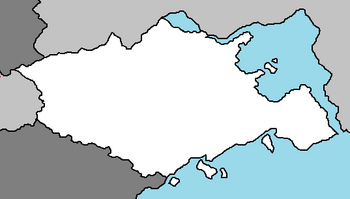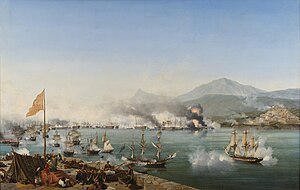Syraranto: Difference between revisions
No edit summary |
|||
| Line 105: | Line 105: | ||
====Formation of the Republic (1928)==== | ====Formation of the Republic (1928)==== | ||
====Civil War (1956-59)==== | ====Civil War (1956-59)==== | ||
====[[Chezian War (1992-95)]]==== | |||
====Reconstruction==== | ====Reconstruction==== | ||
==Geography== | ==Geography== | ||
Revision as of 20:51, 30 July 2020
Republic of Syraranto | |
|---|---|
|
Flag | |
 | |
| Capital | Covijo |
| Government | Unitary parliamentary republic |
| Kyriakos Tasoulas | |
| Population | |
• 2020 estimate | 31,325,000 |
| Currency | Taxo |
| Date format | mm-dd-yyyy |
The Republic of Syraranto, most commonly known as Syraranto, is a nation in the Coalition of Crown Albatross located on the continent of Nortua, bordered by Constantio, Jacreania, and Achijan, with a maritime border with Vuswistan. It has the longest coastline on the Sotoa Sea Basin at 10,676 km in length, featuring many islands, of which 227 are inhabited. Eighty percent of Syraranto is mountainous, with Mount Sojian being the highest peak at 2,918 metres (9,573 ft). The capital and largest city of Covijo is one of the historically longest inhabited cities on Iearth, with a population of 5,893,000.
Syraranto rose as a regional power during the middle ages when the various regional kings created an alliance and conquered much of the coast along the Sotoa Sea. In the 16th century, the alliance was conquered and annexed by the Constantio Empire. The alliances remained under Constantio rule until the Chezian Wars of Independence (1806-23), which involved Syraranto's own revolution resulting in its nationhood. In 1928, a republic was formed and following a rich economic boom became a regional power once again among Chezian states. A devestating civil war from 1956-59 severely ruined the country's infrastructure, but investments from C.C.A. sponsor nations such as South Sotoa, Avergnon, and Zamastan helped progress a period of reconstruction. Syraranto's involvement and military performance in the Chezian War (1992-95) cemented it's power in the region
Syraranto is a unitary parliamentary republic and developed country with an advanced high-income economy, a high quality of life, and a very high standard of living. Syraranto's unique cultural heritage, large tourism industry, prominent shipping sector and geostrategic importance classify it as a middle power.
History
Prehistory and early history
Medieval period (4th-15th century)
Constantio Rule (16th century-1811)
Modern Period
Syraranto War of Independence (1811-1818)
Kingdom of Syraranto (1820-1927)
Formation of the Republic (1928)
Civil War (1956-59)
Chezian War (1992-95)
Reconstruction
Geography
Demographics
Religion
Language
Cities
Politics
Legislature
President
Military
The Syraranto Armed Forces are overseen by the Syraranto National Defense General Staff, with civilian authority vested in the Ministry of National Defence. It consists of three branches:
- Syraranto Army
- Syraranto Navy
- Syraranto Air Force
Moreover, Syraranto maintains the Syraranto Coast Guard for law enforcement at sea, search and rescue, and port operations. Though it can support the navy during wartime, it resides under the authority of the Ministry of Shipping.
Syraranto military personnel total 167,450, of whom 82,950 are active and 80,500 are reserve. Syraranto ranks 17th in the world in the number of citizens serving in the armed forces, due largely to compulsory military service for males between the ages of 19 and 45 (females are exempted from conscription but may otherwise serve in the military). Mandatory military service is nine months for the Army and one year for the Navy and Air Force. Additionally, Syraranto males between the ages of 18 and 60 who live in strategically sensitive areas may be required to serve part-time in the National Guard. However, as the military has sought to become a completely professional force, the government has promised to reduce mandatory military service or abolish it completely.
As a member of the Coalition of Crown Albatross, the Syraranto military participates in exercises and deployments under the auspices of the alliance, although its involvement in C.C.A. missions is minimal. Syraranto spends over Z$7 billion annually on its military, or 2.3 percent of GDP, the 29th-highest in the world in absolute terms, the seventh-highest on a per capita basis, and the fourth-highest in C.C.A. after Zamastan, Drambenburg, and Yuan. Moreover, Syraranto is one of only six C.C.A. countries to meet or surpass the minimum defence spending target of 2 percent of GDP.
Foreign Relations
Syraranto's foreign policy is conducted through the Ministry of Foreign Affairs and its head, the Minister for Foreign Affairs, currently Miko Bendenias. Officially, the main aims of the Ministry are to represent Syraranto before other states and international organizations; safeguard the interests of the Syraranto state and of its citizens abroad; promote Syraranto culture; foster closer relations with the Syraranto diaspora; and encourage international cooperation. The Ministry identifies two issues of particular importance to the Syraranto state: regional challenges to Syraranto sovereignty rights in the Sotoan Sea and corresponding airspace and the nuclear tensions with North Sotoa.
Additionally, due to its political and geographical proximity to the heavily populated areas of Nortua, as well as a common geographical enemy in the rogue nuclear state of North Sotoa, Syraranto is a country of significant geostrategic importance, which it has leveraged to develop a regional policy to help promote peace and stability in the Chezian corridor, the Sotoa Sea, and West Nortua. This has accorded the country middle power status in global affairs.
Syraranto is a member of numerous international organizations, including the Council of Nortua, the Chezian Union, the Union for the Sotoa Sea, and the Coalition of Crown Albatross.




